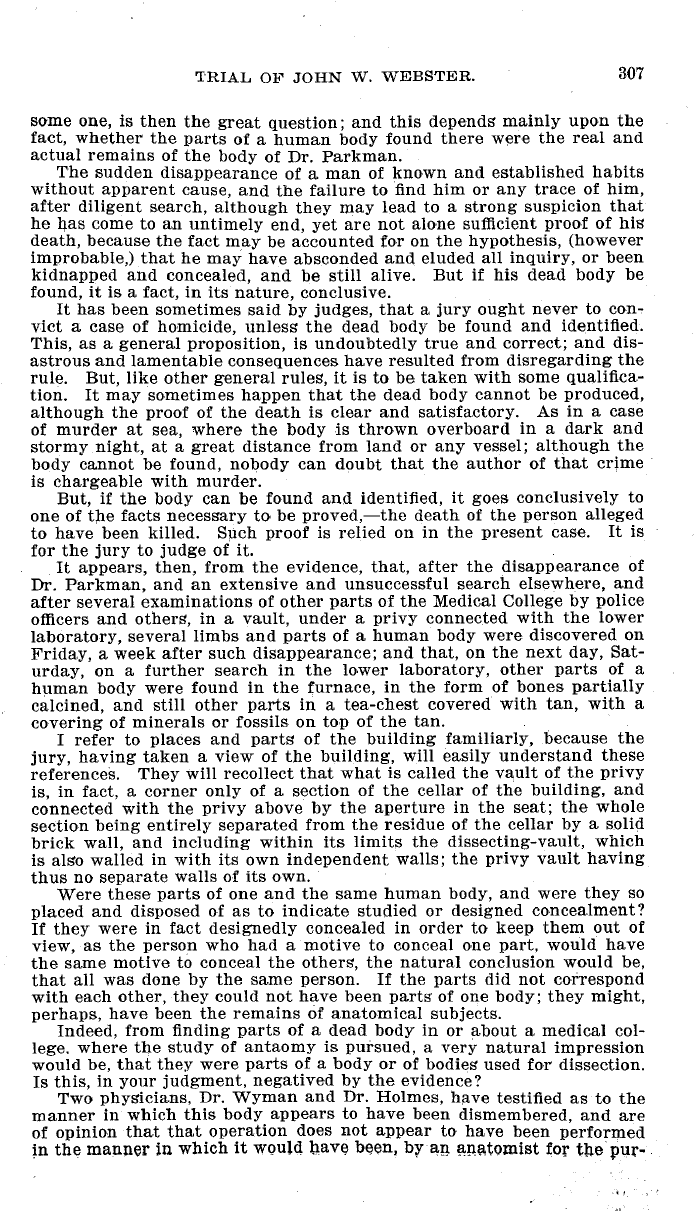|
TRIAL OF JOHN W. WEBSTER. 307
some one, is then the great question; and this depends mainly upon the
fact, whether the parts of a human body found there were the real and
actual remains of the body of Dr. Parkman.
The sudden disappearance of a man of known and established habits
without apparent cause, and the failure to find him or any trace of him,
after diligent search, although they may lead to a strong suspicion that
he has come to an untimely end, yet are not alone sufficient proof of his
death, because the fact may be accounted for on the hypothesis, (however
improbable,) that he may have absconded and eluded all inquiry, or been
kidnapped and concealed, and be still alive. But if his dead body be
found, it is a fact, in its nature, conclusive.
It has been sometimes said by judges, that a jury ought never to con-
vict a case of homicide, unless the dead body be found and identified.
This, as a general proposition, is undoubtedly true and correct; and dis-
astrous and lamentable consequences have resulted from disregarding the
rule. But, like other general rules, it is to be taken with some qualifica-
tion. It may sometimes happen that the dead body cannot be produced,
although the proof of the death is clear and satisfactory. As in a case
of murder at sea, where the body is thrown overboard in a dark and
stormy night, at a great distance from land or any vessel; although the
body cannot be found, nobody can doubt that the author of that crime
is chargeable with murder.
But, if the body can be found and identified, it goes conclusively to
one of the facts necessary to be proved,-the death of the person alleged
to have been killed. Such proof is relied on in the present case. It is
for the jury to judge of it.
It appears, then, from the evidence, that, after the disappearance of
Dr. Parkman, and an extensive and unsuccessful search elsewhere, and
after several examinations of other parts of the Medical College by police
officers and others, in a vault, under a privy connected with the lower
laboratory, several limbs and parts of a human body were discovered on
Friday, a week after such disappearance; and that, on the next day, Sat-
urday, on a further search in the lower laboratory, other parts of a
human body were found in the furnace, in the form of bones partially
calcined, and still other parts in a tea-chest covered with tan, with a
covering of minerals or fossils on top of the tan.
I refer to places and parts of the building familiarly, because the
jury, having taken a view of the building, will easily understand these
references. They will recollect that what is called the vault of the privy
is, in fact, a corner only of a section of the cellar of the building, and
connected with the privy above by the aperture in the seat; the whole
section being entirely separated from the residue of the cellar by a solid
brick wall, and including within its limits the dissecting-vault, which
is also walled in with its own independent walls; the privy vault having
thus no separate walls of its own.
Were these parts of one and the same human body, and were they so
placed and disposed of as to indicate studied or designed concealment?
If they were in fact designedly concealed in order to keep them out of
view, as the person who had a motive to conceal one part, would have
the same motive to conceal the others, the natural conclusion would be,
that all was done by the same person. If the parts did not correspond
with each other, they could not have been parts of one body; they might,
perhaps, have been the remains of anatomical subjects.
Indeed, from finding parts of a dead body in or about a medical col-
lege. where the study of antaomy is pursued, a very natural impression
would be, that they were parts of a body or of bodies used for dissection.
Is this, in your judgment, negatived by the evidence?
Two physicians, Dr. Wyman and Dr. Holmes, have testified as to the
manner in which this body appears to have been dismembered, and are
of opinion that that operation does not appear to have been performed
in the manner in which it would have been, by 44 anatomist for t1le pur-
|

